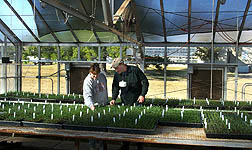| Read the
magazine
story to find out more.
|
| 
Technician Dana Smith (left) and geneticist Jason
Goldman evaluate new bluegrass hybrid seedlings at Woodward. Click the image
for more information about it.
|
|

|
Finding Better Year-Round Forage
By Ann Perry
January 25, 2008 A herd of hungry cattle isn't a
pretty sight. So scientists with the Agricultural Research Service (ARS) are developing forage grasses that
provide nutritious forage to livestock in the southern Great Plains throughout
the year.
A key goal of this work is producing both warm-season and cool-season forage
grasses that can live for long periods on highly erodible lands. Candidates
need to be able to withstand major challenges from extended dry spells, insect
pests and plant diseases.
ARS rangeland scientist
Phillip
Sims, agronomist
Tim
Springer and plant geneticist
Jason
Goldman work at the ARS Southern Plains Range Research Station (SPRRS),
Woodward, Okla. Research at Woodward revolves around three grasses native to
the southern Plains—Texas bluegrass (Poa arachnifera), eastern
gamagrass (Tripsacum dactyloides) and sand bluestem (Andropogon
hallii).
In 2005, the Woodward station released an important new eastern gamagrass
called "Verl." It was the first gamagrass release that had been
selected from a hybrid breeding program. In field trials, Verl equaled or
surpassed standards set by "Pete," a highly productive gamagrass
released in 1988.
Springer was a driving force behind a new sand bluestem variety called
"Chet." This grass has a forage dry matter yield almost 9 percent
greater than that of "Woodward," a key sand bluestem variety
developed during the 1950s.
Hardy Texas bluegrass has survived heat and drought for centuries. But it is
susceptible to diseases like leaf rust, and the seed is difficult to harvest
and plant.
Goldman and Sims are developing useful forage hybrids for the southern
Plains by cross-breeding Texas bluegrass with other grass species and with
bluegrasses from other regions. They have produced more than 80 hybrid types,
many of which are complex hybrids of three different species. Although these
species are not released yet, they offer great promise as feed for cattle in
U.S. Southern Plains.
Read
more about this research in the January 2008 issue of Agricultural
Research magazine.
ARS is the U.S. Department of
Agriculture's chief scientific research agency.